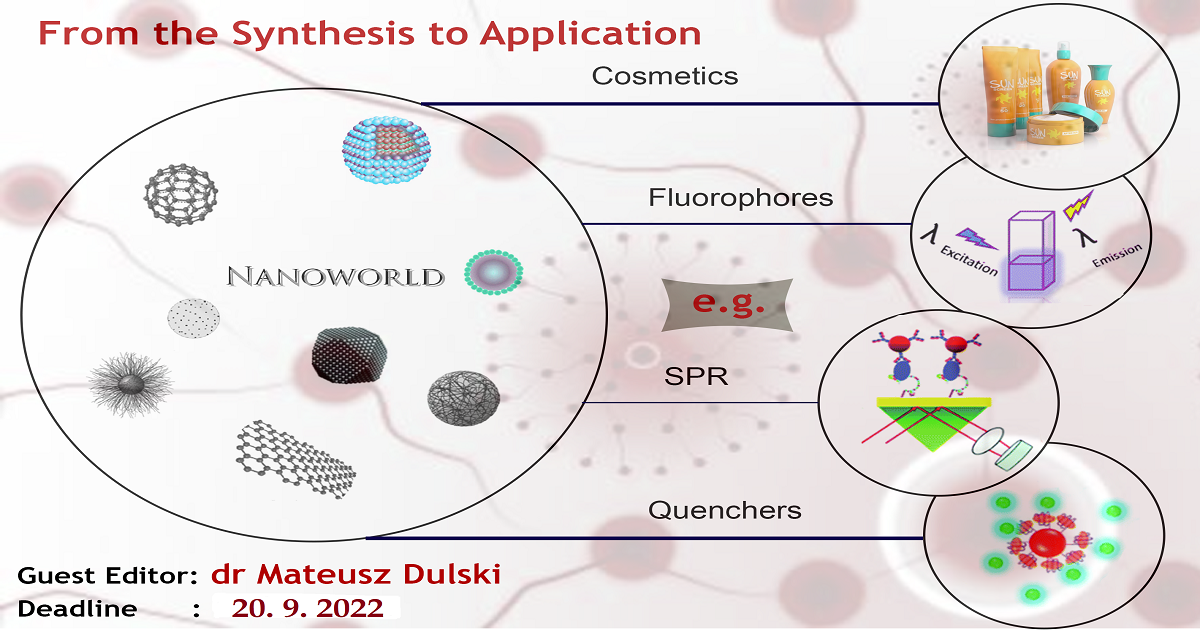Nanoparticles and Nanotechnology: From the Synthesis to Application
A special issue of Materials (ISSN 1996-1944). This special issue belongs to the section "Advanced Nanomaterials and Nanotechnology".
Deadline for manuscript submissions: closed (20 September 2022) | Viewed by 25216

Special Issue Editor
Interests: nanomaterials; composite systems; multifuntional structures; silica-based systems; infrared and Raman spectroscopy
Special Issues, Collections and Topics in MDPI journals
Special Issue Information
Dear Colleagues,
One of the routes to developing a multifunctional engineering system seems to be “evolutionary nanotechnology”. The main goal of such an approach is the improvement of the existing processes, materials, and applications by scaling them down into the “nano” realm and ultimately fully exploiting the unique surface phenomena of that matter. Among the nanomaterials (Φ ~100 nm) that have been fabricated for various applications are carbon, carbon nanotube, metallic, and ceramic particles, which are particularly desirable in the environmental, biomedical, and construction sectors. Such components allow us to enhance the physicochemical, biological (comparable to the real components of human bone), and mechanical parameters in relation to bulk ones. As a result, structures prepared in the form of nanocomposites can be widely used in different fields, including electronics, energy storage, sensing, catalysis, and biology. In addition, they may replace and improve the material properties commonly used in daily life. Hence, many research groups around the world are focused on the development and investigation of novel substances or materials with a broad spectrum of applications. Therefore, I would like to invite all researchers interested in the field of nanomaterials to consider publishing a paper in this Special Issue. We hope that your studies will result in the preparation of high-quality original research articles.
Dr. Mateusz Dulski
Guest Editor
Manuscript Submission Information
Manuscripts should be submitted online at www.mdpi.com by registering and logging in to this website. Once you are registered, click here to go to the submission form. Manuscripts can be submitted until the deadline. All submissions that pass pre-check are peer-reviewed. Accepted papers will be published continuously in the journal (as soon as accepted) and will be listed together on the special issue website. Research articles, review articles as well as short communications are invited. For planned papers, a title and short abstract (about 250 words) can be sent to the Editorial Office for assessment.
Submitted manuscripts should not have been published previously, nor be under consideration for publication elsewhere (except conference proceedings papers). All manuscripts are thoroughly refereed through a single-blind peer-review process. A guide for authors and other relevant information for submission of manuscripts is available on the Instructions for Authors page. Materials is an international peer-reviewed open access semimonthly journal published by MDPI.
Please visit the Instructions for Authors page before submitting a manuscript. The Article Processing Charge (APC) for publication in this open access journal is 2600 CHF (Swiss Francs). Submitted papers should be well formatted and use good English. Authors may use MDPI's English editing service prior to publication or during author revisions.
Keywords
- porous nanomaterials
- hybrid nanostructures
- functional materials
- nanocomposites
- host–guest systems
- synthesis
- functional units
- functionalisation methods
- physicochemical features (optical, magnetic, etc.)
- biological investigations
Benefits of Publishing in a Special Issue
- Ease of navigation: Grouping papers by topic helps scholars navigate broad scope journals more efficiently.
- Greater discoverability: Special Issues support the reach and impact of scientific research. Articles in Special Issues are more discoverable and cited more frequently.
- Expansion of research network: Special Issues facilitate connections among authors, fostering scientific collaborations.
- External promotion: Articles in Special Issues are often promoted through the journal's social media, increasing their visibility.
- Reprint: MDPI Books provides the opportunity to republish successful Special Issues in book format, both online and in print.
Further information on MDPI's Special Issue policies can be found here.






